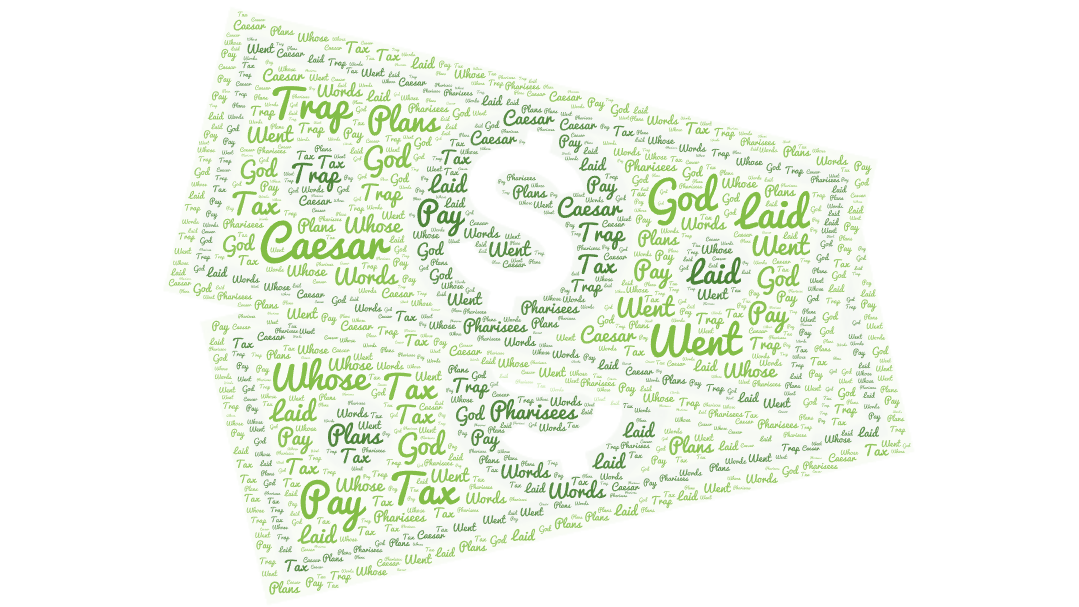Matthew 22:15–22 is one of Jesus’ most brilliant encounters with His opponents. The Pharisees and Herodians try to trap Him with a loaded question: “Is it lawful to pay the imperial tax to Caesar or not?” If Jesus says yes, He alienates Jewish nationalists who resent Rome’s rule. If He says no, He risks arrest for treason. Instead, Jesus asks for a coin, points to Caesar’s image on it, and says, “Give back to Caesar what is Caesar’s, and to God what is God’s.”
loaded question: “Is it lawful to pay the imperial tax to Caesar or not?” If Jesus says yes, He alienates Jewish nationalists who resent Rome’s rule. If He says no, He risks arrest for treason. Instead, Jesus asks for a coin, points to Caesar’s image on it, and says, “Give back to Caesar what is Caesar’s, and to God what is God’s.”
This reply does more than avoid a trap. It reframes the entire issue of allegiance. Coins may bear Caesar’s image, but human beings bear the image of God (Gen. 1:27). Taxes may belong to earthly rulers, but our whole selves belong to God. Jesus is not dodging politics—He’s redirecting attention to the deeper question of identity. Who owns us? Who shapes us? Where does our loyalty ultimately lie?
For disciples, the answer is clear. We may live in the world, navigate civic responsibilities, and honor governments, but our ultimate allegiance is to the One whose image we bear. Our worship, our obedience, our very lives are “rendered” back to God. In Wesleyan language, this is the call to holiness—to let every thought, word, and action reflect that we belong to God in Christ (Collins). Apologetically, this passage reminds skeptics that Christianity is not about escaping the world but about living faithfully within it, as those who know where true ownership lies.
This short but sharp teaching forces us to wrestle with competing loyalties. We live in nations, pay taxes, and respect laws, but none of those identities eclipse the deeper truth: we belong to God. As disciples, we give Him not just what we produce, but who we are.
Origin
and Name:
The Gospel of Matthew takes its name from the apostle Matthew, also called
Levi, one of Jesus’ twelve disciples. Early tradition associates it with a
Jewish-Christian audience.
Authorship: Though disputed, church tradition
attributes the gospel to Matthew the tax collector. Scholars note the author’s
deep knowledge of Jewish law and Scripture, suggesting a Jewish believer
writing for a community wrestling with the relationship between Jesus and the
Law (Brown).
Date
and Setting:
Likely composed between 80–90 CE, after the destruction of the Jerusalem
Temple, Matthew addresses Jewish Christians navigating identity in a time of
upheaval (France).
Purpose
and Themes:
Matthew highlights Jesus as the fulfillment of Old Testament prophecy, the true
teacher of righteousness, and the promised Messiah. The gospel emphasizes the
kingdom of heaven, discipleship, and the inclusion of Gentiles.
Structure: Matthew alternates between narrative
and five major teaching sections, echoing the five books of Moses. The parable
of the wedding banquet falls in the final teaching section, where Jesus
confronts Israel’s leaders.
Significance: Matthew presents Jesus as
Emmanuel—God with us—and calls the church to live out His kingdom mission with
boldness and obedience.
This passage follows the parable of the wedding banquet and continues Jesus’ confrontation with the Pharisees. It shifts from parables to direct challenges, revealing the leaders’ intent to trap Him. In Matthew’s narrative, this exchange foreshadows the tension that will lead to the cross (France).
Biblically, the “image” language echoes Genesis 1:27, where humans are created in God’s image. Paul later expands this idea: believers are being “conformed to the image of his Son” (Rom. 8:29) and “transformed into his image with ever-increasing glory” (2 Cor. 3:18). Revelation 7:9–10 shows this fulfilled as people from every nation, bearing God’s image, worship before the throne. This consistency underscores the apologetic point: Scripture’s thread is not about coins and empires but about who bears God’s likeness and where true allegiance lies (Wright).
Wesleyan theology emphasizes both personal and social holiness. Jesus’ statement in this text balances those well. We honor earthly authorities where appropriate, but our highest loyalty is to God, whose image is stamped on us. This is the Methodist call to live as “altogether Christians,” wholly devoted to God in every sphere of life (Outler).
John Wesley himself insisted that discipleship was not merely inward piety but lived holiness. To “render unto God what is God’s” is to give our hearts fully to Him and let that surrender shape how we live in society. For Methodists, this text reinforces prevenient grace (God’s image stamped on all people), justifying grace (the call to return to God in Christ), and sanctifying grace (our daily transformation into God’s likeness) (Maddox).
• Genesis 1:27 – Humanity created in God’s image. Apologetically, this grounds Jesus’ point: identity, not money, is the deepest issue.
• Romans 12:1 – Offer your bodies as living sacrifices. Discipleship means giving God ourselves, not just external duties.
• 2 Corinthians 3:18 – We are transformed into God’s image. Christianity is about inward renewal, not outward tokenism.
• Philippians 3:20 – “Our citizenship is in heaven.” This defends Christianity against charges of disloyalty—earthly allegiance is real but secondary.
• Revelation 7:9–10 – The redeemed bear God’s image in eternal worship. Apologetically, this demonstrates the unity of Scripture’s vision.